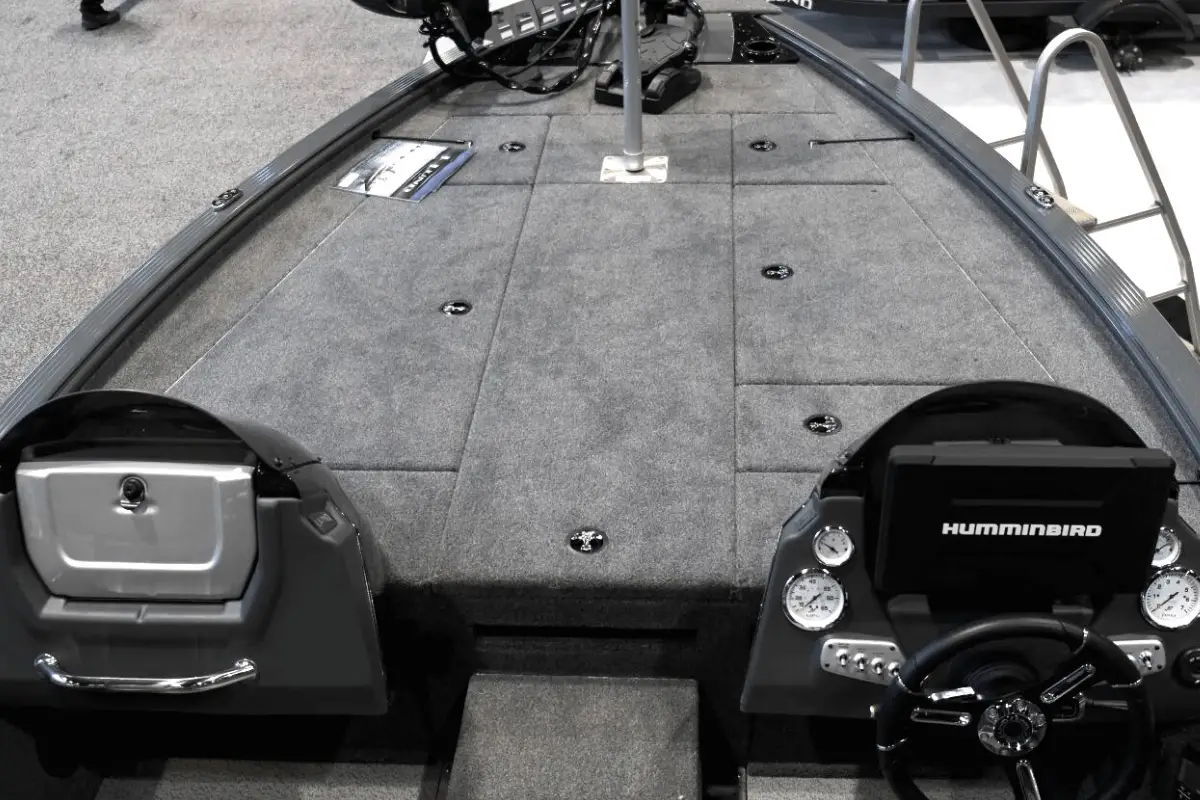For those looking to buy their first bass boat, there are a lot of questions and terminology that may be new. This guide will answer some of those questions and help you on your way to purchasing a boat that will best suit your needs.
Purchasing a bass boat can be an overwhelming process. There are numerous factors to consider including length, horsepower, trolling motor, electronics, and other rigging options. This guide will dive into the basics of boat selection to ensure you are happy with the purchase for many years.
In this article, I will cover all the features of a bass boat from bow-to-stern and answer some of the most common questions.
What Make a Bass Boat a Bass Boat
The pursuit of bass is unique in the fact that there are so many techniques that can be used to catch them. There are also times when these sportfish are in extremely shallow water.
The majority of bass anglers best utilize these techniques by standing.
Bass boats have a spacious front deck that accommodates the movement and rod positions necessary to make efficient and accurate casts. This specialty craft also has a shallow draft and stable hull to make shallow water access easy.
Most bass boats are designed to comfortably fish 2-3 anglers in a standing position.
The storage option for both rods and tackle are also at the core of what makes a bass boat special.
Fiberglass vs. Aluminum
This topic is often discussed and the line between these two types of boats is becoming more blurred.
In the past, the fiberglass rigs were the creme-de-la-creme and are what serious anglers strived for.
Today’s aluminum models are not only durable but just as powerful and fishable.
Nearly every bass boat manufacturer offers fiberglass and aluminum options. I have an entire article on the pros and cons of the two types of rigs here.
Here is a quick rundown though:
Fiberglass is traditionally a higher-priced boat, but is very stable, offers incredible storage, and has a strong transom that can support heavier motors and shallow water anchoring systems. As mentioned earlier, this line is less distinct today with some of the top-end aluminum models available.
Aluminum has traditionally been lower-priced but offers incredible durability. This is nice in waters with lots of rock and other hazards that may damage a traditional fiberglass hull. Aluminum boats are lighter and therefore can run well on smaller horsepower motors saving both in cost and fuel consumption.
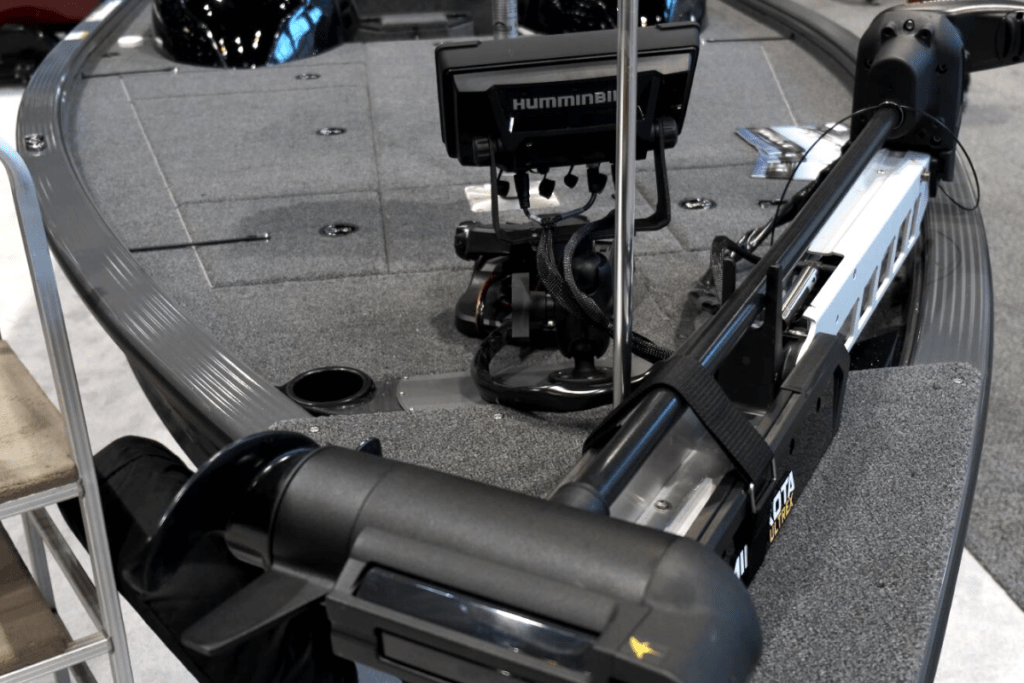
The Trolling Motor
A bass angler spends 99% of his-or-her time at the bow of the boat. The trolling motor is used more than any other piece of equipment and needs to be durable, dependable, and functional.
Pounds of Thrust and Voltage
Trolling motors are defined by the voltage they run on. Anglers can opt for 12v, 24v, or 36 volt systems. A 24v system uses two 12v batteries and a 36v system utilizes 3.
Selecting a trolling motor is an important decision and the types of water you fish should be the main factor when making this choice.
Most 12v motors have a thrust rating around 46lbs. Many 24v systems will be in the rage of 84lbs of thrust and the 36v systems crank out thrust in the 112lb range.
The weight of the boat is the primary consideration when choosing a trolling motor, but, most pre-rigged packages tend to be underpowered in my opinion.
Both wind and current can ruin your day on the water if the trolling motor is not big enough to handle the situation. For example, when I purchased my latest aluminum bass boat, it came with a 12v 46lb thrust motor. In completely calm conditions, this was fine.
Add some wind and current and it performed poorly.
I then upgraded to a 24v 86lbs of thrust system. It may seem too big for an 18ft aluminum bass boat, but I never have issues with power anymore. On the windiest of days, I only need to operate the trolling motor at 50-60% power which saves battery life and is less stressful on the motor itself.
I can also fish river systems, like the Mississippi, and operate the boat into the current and still move upstream with no trouble. This allows for proper boat control and better presentations.
Purchasing the largest trolling motor the boat can handle is something you will not regret.
For a complete article on the four newest bass boat trolling motors on the market, click here.
Trolling Motor After Market Upgrades
There are a couple of upgrades that you can add to your trolling motor I think you will find helpful.
The first is to change out the standard pull rope that comes with most motors and upgrade to a steel cable. Both TH Marine and Bob’s Machine Shop offer excellent aftermarket cables.
There is nothing worse than having the trolling motor rope break when pulling it up.
The second aftermarket addition you may want to consider is a prop nut. Once again, TH Marine and Bob’s offer options that will fit most models on the market.
These additions make it easier to take the prop on-and-off plus it reduces vibration.
Another popular add-on is a stabilizer used when the trolling motor is stowed. This reduces bounce both on the water and when traveling down the highway.
Trolling Motors with GPS Anchoring
In my opinion, this is a must-have option.
There are four models right now that have push-button GPS anchoring systems that will hold the boat in position while you attend to a fish, change a lure, or help someone else in the boat.
These models are the Minn Kota Ultrex, the Motorguide Tour Pro, the Lowrance Ghost, and the Garmin Force.
There are very few “guarantees” in the bass fishing world, but I do guarantee that you will catch more fish because of this feature.
Wind, current, and boat wakes can push your rig off of its spot. There are times in the past where a strong wind blew me fifty yards out of position while I worked on tackle.
Each brand boasts a different number in regards to holding accuracy, but any of them would be a huge improvement over other models.
Since the majority of the fishing day is spent on the trolling motor, spending a little more to get a unit with GPS anchoring is something I think you will be very happy with.
Recessed Pedal
While this particular option is almost standard, there are still boats sold without this feature.
A recessed pedal means that the top of the foot control pedal is almost flush with the deck of the boat. The handy feature drastically reduces back fatigue and makes for a comfortable day on the water.
It is also a plus to have the pedal secure in a recessed tray for trailering the boat.
Aftermarket trays can be bought and installed if the model you purchase does not come with one. Be aware, that adding a pedal tray after purchase may impact rod and compartment storage.
The Front Deck is a Bass Angler’s Paradise
The size and layout of the front deck is a close second in importance to the trolling motor.
While the majority of bass boats, both fiberglass and aluminum, offer spacious casting decks, the size of the rig makes a difference. An eighteen footer will have a much smaller deck that a twenty footer.
Think about how big of an angler you are. Do you need more room?
What about fishing partners? How often do you take someone else out that may be sharing the front deck with you?
While these considerations are not deal-breakers, it will make a difference. If the majority of the time you are fishing alone or with one other person, a shorter boat is fine.
If there are times when you will have three anglers in the boat or if you are the size of an NFL lineman, you may want to consider a model with a more spacious deck.
Bow Graph
The addition of a bow graph is pretty much standard equipment if the boat you purchase is in the mid-range and up.
Lower priced models often do not have a bow graph to save on cost.
If you are primarily a shallow water bass angler and never venture offshore, then not having a bow graph is no big deal.
If the bass on your home waters get deep in the summer and winter then having some electronics up front is a must.
Types of Bow Sonar Available
There are many traditional sonar models on the market with down-imaging, chirp, and even megahertz resolutions. Garmin, Lowrance and Humminbird cover about every price-point imaginable.
These units show the most current data on the right side of the screen. As the image scrolls to the left the information gets older.
Each major electronics manufacturer offers some pricier versions that either show images in real-time or very close to it.
Humminbird offers a 360° option which reads just like a doppler radar unit. It allows anglers to see what is going on from all directions. It is also adjustable to read varying degrees, so if a front-only display is called for an angler can dial that up.
Both Garmin and Lowrance offer live, or instantaneous, imaging. Many anglers have called it “video game” fishing.
You can actually see the fish swimming around in real-time. It is quite impressive.
Of course, it comes at a price, but if you plan on fishing away from the bank much of the time it may be an investment you want to consider.
Deck Padding
Some of the higher-priced rigs include this as a standard option and it is often available as an add-on for lower-priced models.
If you tend to have back pain or spend long days on the water, having a padded deck can be a feature worth the money.
Be sure to check the standard and optional equipment listings on the models you are looking at.
Lid Pistons
This seems like such an inconsequential option to talk about, but trust me, if you have storage compartment lids without the pistons, life on the water can be very frustrating.
Just like with bow electronics, most mid-price and all the higher end models will have lid pistons.
Most price-point bass boats do not and it does make a difference.
If the model you are looking at does not include them as standard equipment, ask to see if it is an optional upgrade or if aftermarket options can be installed.
Compartment Security
This is a big one.
I have been on the road many times and seen boats that have had there storage compartments broken into.
If you plan on traveling with your boat, look into some sort of compartment security.
There are several options available that includes a locker bar that mounts across all the lids and into the side of the gunnel to deter theft.
Even having a nice tarp fastened to the boat at night can add some deterrence, but is not a security measure.
Tool Storage
What are the tools that you like to use during the fishing day?
Where are you going to keep things like braid scissors, pliers, clippers, etc.
The placement of these items are accounted for in different places on the different bass boat models. Some offer exceptional bow storage options for tools while other have handy compartments near the step to the front deck.
Where are they most convenient for you?
This is not something that is a make-or-break deal in a bass boat purchase, but often an afterthought.
Single or Dual Console – Leg Room
I get this question asked a lot.
Single console rigs offer a lot of extra room and plenty of deck space near the cockpit. Dual consoles are nice for passengers to stay comfortable during long rides across the lake or river.
Most tournament anglers opt for single console bass boats because it allows enough space to fight big fish and have a place to sit down and land them.
A nice option is to consider a boat that has a removable dual console. Usually a few quick turns of some oversized latches will allow the port side console to be taken out for single console operation.
Larger anglers also find single console boats more comfortable to fish from and operate.
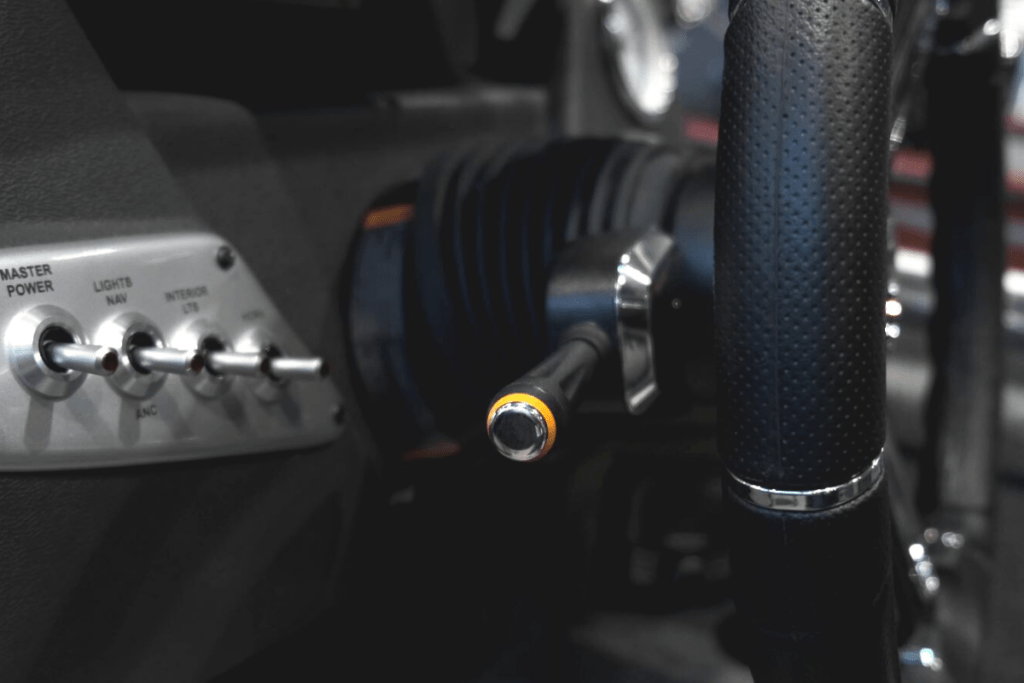
Hydraulic Steering
This usually comes standard on bass boats with larger outboards. The torque generated by a big motor can make steering difficult.
Take a moment to make sure that the boat you are looking at has hydraulic steering as either standard equipment or as an option.
If you are operating smaller bass boats with less horsepower, a traditional steering setup works fine.
Hot Foot
Boats that have a Hot Foot installed give the operator throttle control on the floor as opposed to keeping one hand on the starboard mounted throttle control.
A major plus of a Hot Foot is that the boat is safer to operate because both hands can be on the wheel at all times.
A downside can be ankle fatigue on long runs.
Anglers with long legs will want to make sure that the Hot Foot is placed in a comfortable position. I have seen many units installed that force the driver to keep their leg bent at an uncomfortable angle.
I have had boats with and without a Hot Foot and I definitely prefer a boat that has one.
Most of the time if this is an option, the trim controls and jackplate controls will also be on the steering column keeping both hands on the wheel.
Console Graphs
The console graphs are important if an angler plans on making long runs and scanning with the side-imaging units to look for bass, structure, or other types of cover.
You may have noticed many top tournament pros have two large graphs mounted above the steering column.
Often, one is dedicated to a GPS controlled map and the other is used for scanning the water.
This is very handy, but not needed for the everyday angler.
The units offered by the major manufacturers have multiple display modes that allow for split screen capabilities that offer almost endless configurations allowing for simultaneous mapping and underwater display.
Rear Deck
There considerable differences in rear storage options across the different manufacturers of bass boats.
Some rigs offer a more bow-centric weight distribution that allows for a larger back deck.
Other models sit the console towards the rear and the result is a smaller back deck.
Once again, what type of fishing are you doing and who is going to be with you? If the majority of the time an angler is alone or with one other person sharing the front deck, the rear deck space is not a concern.
If more than two anglers will be out then it is something that needs to be considered.
Pro Seats vs. Standard Seats
The traditional bass boat package comes with one Pro Seat in the front and a traditional folding seat for the back deck.
Options for most companies include purchasing a second pro seat or a second standard seat.
The pro seats are nice for anglers that like to stand and use it as support to lean into.
Many anglers also leave all of the pedestal seats at home and keep the decks wide open to allow for maximum maneuverability.
Think about how you fish and make sure the seating options are best suited for your style.
Bass Boat Livewells
Tournament anglers use livewells all the time. If you do not see yourself fishing a tournament you may never use them.
Either way, livewell care is important.
Keep them clean and remove all debris so the pumps and hoses do not become plugged. A small brush and net, like used for tropical fish tanks, are handy accessories to keep with you for livewell maintenance.
The livewells on today’s top-dollar rigs are quite impressive. They offer the best in fish care so those bass can be returned to the lake to be caught another day.
Cooler, Glovebox, and Garbage Receptacle
When I ordered my first bass boat, these items were not even on the radar of what was important.
They are now.
Cooler placement, glovebox size, and the garbage receptacle are all items that need consideration because anglers access them constantly.
Each manufacturer has different layouts and options on their mid- and high-end boats. Most price-point models may be lacking all of these to hit a more wallet-friendly MSRP.
It is amazing how much garbage a bass angler generates in a day of fishing. From line clippings to worn out soft plastics, the pile grows at a rapid rate. Having a dedicated place to throw discarded items where they do not litter the boat deck is a very nice option.
Battery Compartment on Bass Boats
I can honestly say, the thought and design put into the battery compartment has vastly improved in recent years.
This is a compartment you hope to never need, but you will. I promise.
When the batteries are laid out in a smart manner with plenty of space to access pumps, chargers, and other critical features, life is much better. This is especially true when there is an on-water issue that needs to be resolved.
Some compartment also offer removable trays that can be handy to keep items that are rarely used, like a tow strap, etc.
Battery Charger
If the trolling motor is one of the most important items on a bass boat, this has to be right behind it.
Price-point rigs come with models that offer a low per-bank output and a slow charge time.
Top-end rigs have better chargers, but aftermarket options offer some tremendous onboard chargers that will not only take care of your batteries, but will extend their overall lifespan.
Be sure to check the total amps the charger lists and then divide that per bank. A 30 amp charger that has three banks will output 10 amps per bank.
A 36v system will have 3 deep cycle batteries and one cranking battery for a total of 4. Be sure that the charging system is a 4 bank charger. Sometimes you will find boats rigged with four batteries and only a 3 bank charger because the outboard alternator will take care of the cranking battery.
True, but knowing that that cranking battery is fully charged everytime you back the boat into the water is a comforting feeling. Especially with all of the accessories and graphs modern bass boats have on them.
Battery Type
Depending on the budget an angler has, a lot of money can be dropped on batteries.
There are traditional FLA (Flooded Lead Acid), AGM (Absorbant Glass Mat), and Lithium.
Each battery type has its advantages and disadvantages. For a complete breakdown of bass boat batteries, check out this article.
Outboard Size Rating
I have run across so many anglers that regret making the wrong outboard purchase.
This is usually the first area a potential buyer cuts costs – because an outboard is a considerable investment.
Every boat has a Coast Guard rating that designates that maximum horsepower allowed for that hull. Purchasing the maximum outboard the boat can take will reduce headaches, maintenance costs, and wear-and-tear on the motor.
If cost needs to be brought down, purchasing a smaller outboard is not the place to do it. Purchasing a smaller bass boat would be a better option.
Here’s my opinion why.
An undersized motor will run at much higher RPMs as the driver attempts to get the maximum performance from the motor. Redlining an engine is never a good idea.
Undersized motors also result in poor hole shot and handling performance.
Bass anglers are notorious for carrying an excessive amount of gear. This weight adds up. A motor designed to handle that load will make for a much better experience on the water.
Purchasing an undersized motor also results in more fuel consumption because, once again, the motor is run at higher RPMs to maintain performance.
I have never talked to an angler that regretted buying the max rated HP for the boat they purchased. I have talked to many, many, anglers that regret buying a motor that is too small.
A 20ft bass boat with the max motor will be a better decision to save money than to buy a 21ft bass boat with a smaller motor.
4 Stroke vs 2 Stroke
Most new bass boats are coming with 4 strokes now.
A 2 stroke motor is still an option, but the quiet performance the 4 stroke offers is hard to beat.
The maintenance is a little different on a 4 stroke since the oil needs to be changed a few times a season, instead of injected into the fuel like on a 2 stroke.
Take your budget into consideration when deciding between the two motor types and be sure to ask your dealer what their opinion is.
Hole Shot
This term refers to how fast the boat will come from a resting position to fully on pad, or plane.
There are many factors that impact hole shot including weight, weight distribution, the jackplate and offset, as well as the prop.
For most recreational anglers, hole shot is not something that is a huge concern when choosing a boat. Most models on the market today have good hole shot and it is operator modifications and rigging that can really make a difference.
With the proper jackplate setup it is possible to get up on plane in very shallow water. This is a plus if fishing an area where it normally would take idling out to deeper water for a proper takeoff.
A bass boat that gets up on plane quickly, or has a good hole shot, can offer the operator safer operation and better performance.
Prop
There are a lot of options an angler can investigate when it comes to choosing a prop for their outboard.
In most instances, the dealer will set the motor up with the proper prop and that is all most anglers will ever need to worry about.
The different blade options as well as pitch can alter the performance of the boat. A three blade prop offers better top speed while a four blade version helps hole shot, especially with boats that have a heavy stern.
You will also hear terms like pitch and diameter.
The diameter of the prop means twice the distance from the center of the hub to the outer edge of the blade. Or the distance from blade tip-to-blade tip.
A prop with a larger diameter has more bite to it and can help get a heavy boat going.
The pitch is important when configuring a prop to work efficiently with the RPMs of the outboard. The two want to work together, not against each other.
Increasing pitch will decrease the engine RPMs and decreasing pitch will increase the RPMs of the engine.
On other words, if the engine is over or under running its RPMS, adjusting prop pitch can solve the problem.
Your dealer should have the appropriate prop for the engine you are selecting. Considerations between a 3 blade and 4 blade may be the only choice needed, especially if you plan on having a heavy load or like to take the family tubing with your bass boat.
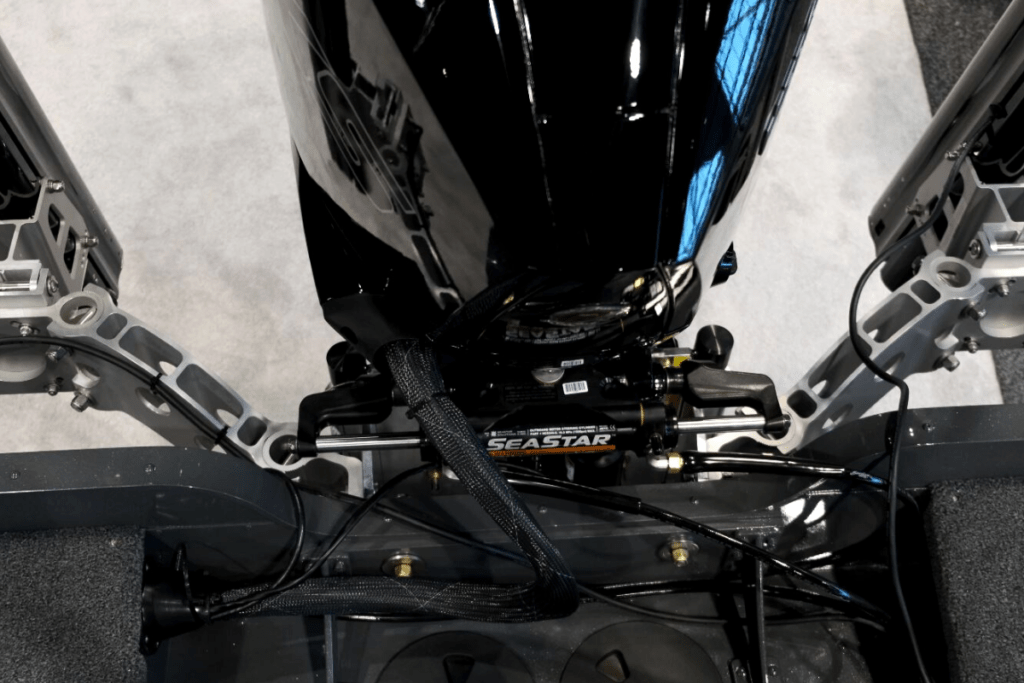
Jackplate
There are two types of jackplates – fixed and hydraulic adjustable.
A fixed jackplate is set by the dealer and bolted in position. Once it is set and tweaked by the dealer, you can basically forget about it. The boat should have acceptable performance for both take off hole shot and running on plane.
For those that want to get maximum performance, control, and ability to take off in shallower water, a hydraulic jackplate is a good option.
This gives the operator control of the engine height and distance the tip of the blade is from the water’s surface. This distance impacts prop slip.
Each engine and boat combination has the optimal jackplate settings for hole shot and running down the lake.
Once on plane the operator will often adjust the jackplate height again.
This all sounds complicated, but once operating the boat on the water it is much easier to understand how adjustments to the hydraulic jackplate impact performance. The operator can both hear and feel how the outboard is operating.
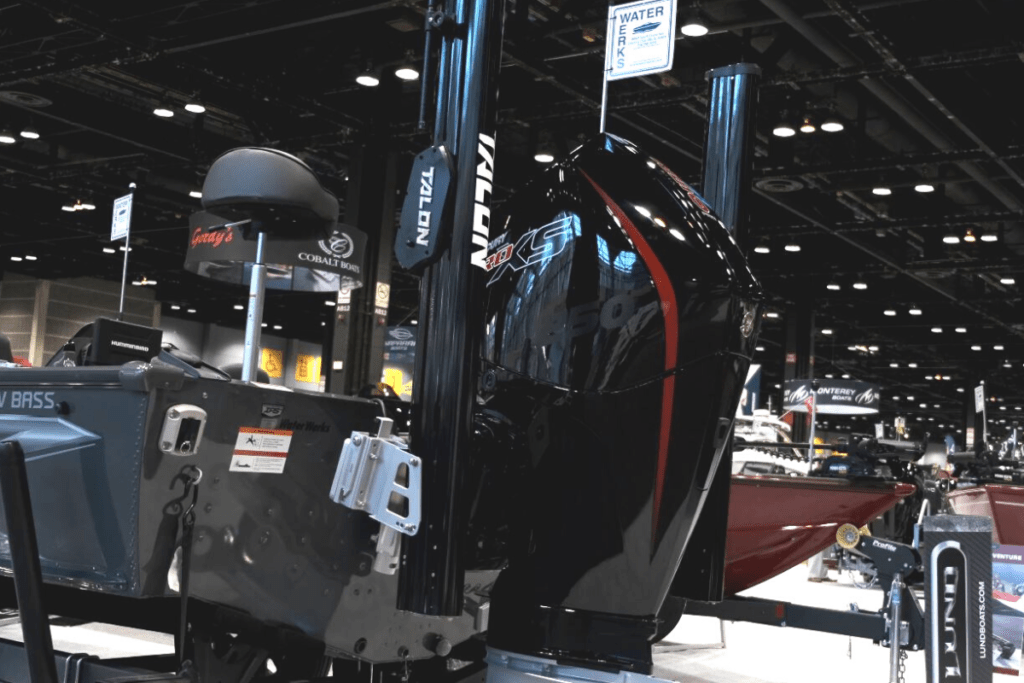
Shallow Water Anchors
These attachments allow a boat to literally be pegged into position.
Mounted on the transom, shallow water anchors lower to the bed of the lake or river and keep the boat from moving. As the name suggests, these are used in shallow water.
The two major brands at this time are Power Pole and Minn Kota Talons.
Power Poles use a hydraulic system and the Minn Kota Talons are electric. The hydraulic system requires additional room in the battery compartment for pumps whereas the Talons hook directly to the batteries.
Power Poles deploy by reaching outward and down. The Talons deploy straight down.
Power Poles come in lengths up to 10ft while the Talons can reach down to 15ft. This is not as big a deal anymore with trolling motors that have GPS anchor lock.
Most bass boats rig two shallow water anchors to hold them securely in position. You can purchase just one, but the boat will spin in heavy wind or current.
Many pro anglers like to have shorter shallow water anchors to keep them out of the way when casting or running around the boat when fighting a fish.
The Power Poles can integrate with select Lowrance electronics and the Minn Kota Talons can communicate with certain Humminbird units.
Like GPS anchors on trolling motors, shallow water anchors are game changers. They allow anglers to hold in position while working a piece of shallow cover. This allows stealth and a secure fishing platform.
These are also handy when pulling up to a dock. The operator can drop the shallow water anchors to hold the boat next to the dock without actually tying up to it. This can eliminate damage to the hull of the boat in rough water or windy conditions.
Boat Trailer
The trailer is important if you plan on having some serious highway time.
For over-the-road applications, I prefer a dual axle trailer. Heavier and larger bass boats come with dual axle trailers as standard equipment.
Some of the mid-sized bass boats offer an option for either a single axle or dual. Smaller bass boats will only have single axle trailer options.
Dual axle trailers are much smoother on the highway. They bounce less and trailer nicely behind the truck. A downside is that dual axle trailers do not pivot as smoothly as a single axle.
A trailer with a single axle is more maneuverable, but can start bouncing down the interstate on uneven surfaces or if there are bumps.
I have had both and prefer the dual axle option hands down, but I do put quite a few miles on the boat trailer.
Final Thoughts
As you prepare to make your purchase, talk to other anglers.
There is going to be no shortage of opinions on any of the above mentioned topics. Find a dealer that you trust and ask questions about before-and-after purchase items.
Buying a bass boat is a major decision and choosing a model that best suits your style and the waters you fish will make for many years of angling satisfaction.
Tight lines. Be safe and be sure to encourage someone today, you never know how you may change their life forever.
Isaiah 6:8

